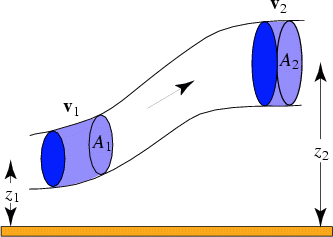Bernoulli's Principle
- Shalmali

- Feb 12, 2021
- 4 min read
Updated: Jul 21, 2021
What are steady-state flow and incompressible flow? What is the continuity equation?
Table of Contents:

Imagine this! You are on a trek! You are walking along beautiful huge green mountains and trees.
Yes! You found the waterfall, that you followed since you heard it. Wonderful isn't it? Ever wondered why water flows in the direction it is flowing?
Nah! The reason is not just due to gravity (obviously it plays a role), but there is another reason too! Before getting into the details, let's understand few basic concepts.
Steady State flow:
Imagine a flowing fluid molecule follows the path PABQ. The direction of velocity at any point in a fluid is tangent to the fluid flow. Let's name the molecule alpha. For example, when alpha reaches point P, its velocity is 10m/s and its direction is as shown in the figure (velocity is a vector quantity). When alpha reaches point A, its velocity is 5m/s and direction as shown in the figure. Further, at point B, 7m/s and at point Q, 11m/s and directions respectively.
Now, a molecule beta which is followed by alpha follows the same path as alpha PABQ. The beta has to follow the same path as alpha to be steady-state. If the molecule beta has the same velocity and direction at each point as alpha then the flow is called Steady flow and streamline flow.
Steady State flow means the velocity (or any other fluid property) of fluid does not change over time at the same point.
Note: Steady flow does not mean the whole fluid has the same velocity.
Streamline:
The imaginary path of flowing fluid is called as streamline.
Incompressible flow:
When the Mach Number is less than 0.3 the fluid is considered to be Incompressible. It simply means that the velocity of the fluid is not large enough for it to get compressed.
Equation of Continuity:
Continuity equation states that the product of cross-sectional area and the velocity is constant through-out the fluid flow.
Bernoulli's Principle:
The assumptions made by Bernoulli's Principle:
It is a steady flow.
It can be applied between two molecules of the same streamline. It cannot be applied between molecules of different streamlines.
It is incompressible flow. Its density does not change over time.
It is inviscid flow. The viscosity of the fluid is zero. There is no friction between the fluid.
It is irrotational flow. The angular velocity of the fluid is zero.
Any fluid flow takes place mainly due to pressure difference. Fluid always flows from high pressure to low pressure. Also, the total pressure in any fluid is always constant. How is that possible?
The high and low pressure that we were talking about earlier is Static pressure and the pressure that needs to be constant throughout the flow is Total pressure. As the fluid is in motion, in this case, Dynamic pressure also exists.
Bernoulli's Principle is based on Conservation of energy in flowing fluids. The Pressure and Gravitational Energy in the flowing fluid should be conserved.

Hence, from the above equation we can infer that:
Bernoulli's Equation states that, for an ideal flowing fluid at any point the summation of Total pressure energy and Gravitational energy remains constant.
Referring to the figure, as the fluid flows from point 1 to point 2, the area of cross-section increases. Hence, by continuity equation the velocity increases, which means the dynamic pressure increases. Assuming gravitational energy to be negligible, the static pressure will increase. In summation, velocity and pressure are inversely proportional!
Next time whenever you witness a waterfall, remember the flow takes place not only due to gravity but also due to pressure difference.
The Swiss mathematician and physicist Daniel Bernoulli (1700-1782) discovered the principle that bears his name while conducting experiments concerning an even more fundamental concept: the conservation of energy. In a segment of pipe with a relatively large diameter, he observed, water flowed slowly, but as it entered a segment of smaller diameter, its speed increased. It was clear that some force had to be acting on the water to increase its speed. Earlier, Robert Boyle (1627-1691) had demonstrated that pressure and volume have an inverse relationship, and Bernoulli seems to have applied Boyle's findings to the present situation. Clearly the volume of water flowing through the narrower pipe at any given moment was less than that flowing through the wider one. This suggested, according to Boyle's law, that the pressure in the wider pipe must be greater. Hence Bernoulli's conclusion: the slower the rate of flow, the higher the pressure, and the faster the rate of flow, the lower the pressure.

Summary:
Bernoulli's Principle assumes that the flow is ideal fluid flow.
Steady State flow means any fluid property does not change over time at the same point.
Fluid always flows from high static pressure to low static pressure.
The total pressure in any fluid is always constant.
Bernoulli's Equation states that the summation of Total pressure energy and Gravitational energy in an ideal fluid flow remains constant.
Bernoulli's Principle is based on the Conservation of energy in flowing fluids. Not only Gravitational Energy but also Pressure Energy in the flowing fluid should be conserved.
Velocity and pressure are inversely proportional.
What are pressure force and Pressure energy? Want to know more about this topic in detail? Follow me for similar topics!
.png)






Comments